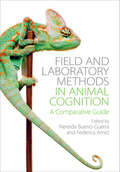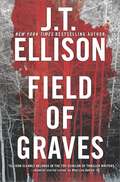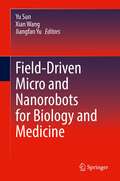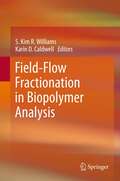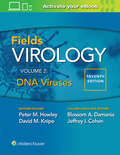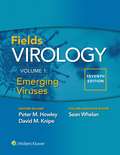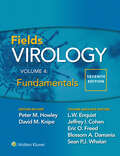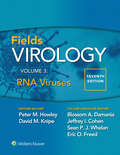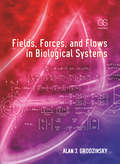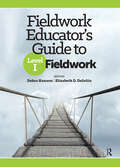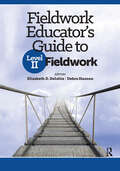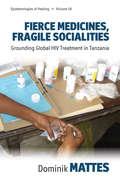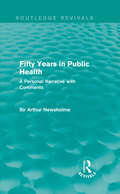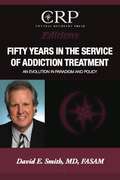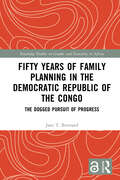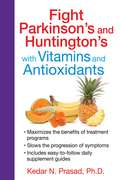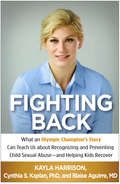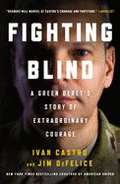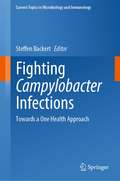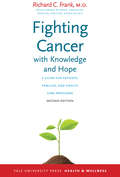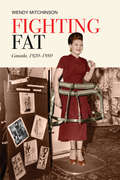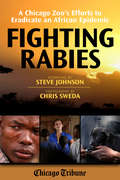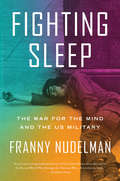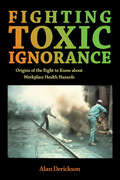- Table View
- List View
Field and Laboratory Methods in Animal Cognition: A Comparative Guide
by Nereida Bueno-Guerra Federica AmiciWould you ask a honeybee to point at a screen and recognise a facial expression? Or ask an elephant to climb a tree? While humans and non-human species may inhabit the same world, it's likely that our perceptual worlds differ significantly. Emphasising Uexküll's concept of 'umwelt', this volume offers practical advice on how animal cognition can be successfully tested while avoiding anthropomorphic conclusions. The chapters describe the capabilities of a range of animals - from ants, to lizards to chimpanzees - revealing how to successfully investigate animal cognition across a variety of taxa. The book features contributions from leading cognition researchers, each offering a series of examples and practical tips drawn from their own experience. Together, the authors synthesise information on current field and laboratory methods, providing researchers and graduate students with methodological advice on how to formulate research questions, design experiments and adapt studies to different taxa.
Field of Graves: A Thrilling suspense novel (A Taylor Jackson Novel #Null)
by J. T. EllisonWith FIELD OF GRAVES, New York Times bestselling author J.T. Ellison goes back to where it all began... All of Nashville is on edge with a serial killer on the loose. A madman is trying to create his own end-of-days apocalypse and the cops trying to catch him are almost as damaged as the killer. Field of Graves reveals the origins of some of J.T. Ellison's most famous creations: the haunted Lieutenant Taylor Jackson; her blunt, exceptional best friend, medical examiner Dr. Samantha Owens; and troubled FBI profiler Dr. John Baldwin. Together, they race the clock and their own demons to find the killer before he claims yet another victim. This dark, thrilling and utterly compelling novel will have readers on the edge of their seats, and Ellison's fans will be delighted with the revelations about their favorite characters.
Field-Driven Micro and Nanorobots for Biology and Medicine
by Yu Sun Xian Wang Jiangfan YuThis book describes the substantial progress recently made in the development of micro and nanorobotic systems, utilizing magnetic, optical, acoustic, electrical, and other actuation fields. It covers several areas of micro and nanorobotics including robotics, materials science, and biomedical engineering. Field-Driven Micro and Nanorobots for Biology and Medicine provides readers with fundamental physics at the micro and nano scales, state-of-the-art technical advances in field-driven micro and nanorobots, and applications in biological and biomedical disciplines.
Field-Flow Fractionation in Biopolymer Analysis
by S. Kim Williams Karin D. CaldwellThis is a timely collection of important biomedical applications for a set of separation/characterization techniques that are rapidly gaining popularity due to their wide dynamic range, high resolution, and ability to function in most commonly used solvent systems. Importantly, the field-flow fractionation (FFF) technique has recently emerged as a prominent complement to size exclusion chromatography for protein pharmaceuticals. Fractionation with FFF is gentle and preserves protein structural integrity better than existing alternatives. In the present text, different chapters are written by experts in their respective field of application, who offer comparisons between the FFF techniques and other methods for characterizing their special focus material. Practical guide-lines for successful implementation, such as choice of operating conditions, are offered in conjunction with each application. In addition to new instrumentation and approaches that address important current topics, readers are provided with an overall sense of prior (but timeless) major developments that may be overlooked in literature searches.
Fields Virology: DNA Viruses
by Jeffrey L. Cohen Peter M. Howley David M. Knipe Blossom A. DamaniaBundled with the eBook, which will be updated regularly as new information about each virus is available, this text serves as the authoritative, up-to-date reference book for virologists, infectious disease specialists, microbiologists, and physicians, as well as medical students pursuing a career in infectious diseases.
Fields Virology: Emerging Viruses
by Peter M. Howley David M. KnipeNow in four convenient volumes, Field’s Virology remains the most authoritative reference in this fast-changing field, providing definitive coverage of virology, including virus biology as well as replication and medical aspects of specific virus families. This volume of Field’s Virology: Emerging Viruses, 7th Edition covers recent changes in emerging viruses, providing new or extensively revised chapters that reflect these advances in this dynamic field.
Fields Virology: Fundamentals
by Peter M Howley David M Knipe Lynn W EnquistNow in four convenient volumes, Field’s Virology remains the most authoritative reference in this fast-changing field, providing definitive coverage of virology, including virus biology as well as replication and medical aspects of specific virus families.
Fields Virology: RNA Viruses
by Eric O. Freed Peter M. Howley David M. Knipe Sean WhelanNow in four convenient volumes, Field’s Virology remains the most authoritative reference in this fast-changing field, providing definitive coverage of virology, including virus biology as well as replication and medical aspects of specific virus families. This volume of Field’s Virology: RNA Viruses, Seventh Edition covers the latest information on RNA viruses, how they cause disease, how they can cause epidemics and pandemics, new therapeutics and vaccine approaches, as provided in new or extensively revised chapters that reflect these advances in this dynamic field. Bundled with the eBook, which will be updated regularly as new information about each virus is available, this text serves as the authoritative, up-to-date reference book for virologists, infectious disease specialists, microbiologists, and physicians, as well as medical students pursuing a career in infectious diseases.
Fields, Forces, and Flows in Biological Systems
by Alan J GrodzinskyFields, Forces, and Flows in Biological Systems describes the fundamental driving forces for mass transport, electric current, and fluid flow as they apply to the biology and biophysics of molecules, cells, tissues, and organs. Basic mathematical and engineering tools are presented in the context of biology and physiology.The chapters are structured in a framework that moves across length scales from molecules to membranes to tissues. Examples throughout the text deal with applications involving specific biological tissues, cells, and macromolecules. In addition, a variety of applications focus on sensors, actuators, diagnostics, and microphysical measurement devices (e.g., bioMEMs/NEMs microfluidic devices) in which transport and electrokinetic interactions are critical.This textbook is written for advanced undergraduate and graduate students in biological and biomedical engineering and will be a valuable resource for interdisciplinary researchers including biophysicists, physical chemists, materials scientists, and chemical, electrical, and mechanical engineers seeking a common language on the subject.
Fieldwork Educator’s Guide to Level I Fieldwork
by Debra Hanson Elizabeth DeIuliisA new resource for occupational therapy academic fieldwork coordinators and fieldwork educators, Fieldwork Educator’s Guide to Level I Fieldwork is a practical guide for faculty and clinicians to design and implement Level I fieldwork experiences for occupational therapy and occupational therapy assistant students.Fieldwork Educator’s Guide to Level I Fieldwork was designed to address the challenges of integrating Level I fieldwork with classroom learning experiences. Expansive and versatile, the book meets the recently expanded definition of Level I fieldwork according to the 2018 Accreditation Council for Occupational Therapy Education standards, including faculty-led experiences, standardized patients, simulation, and supervision by a fieldwork educator in a practice environment.Each unit of the text builds upon the previous unit. The first unit provides fundamental knowledge on experiential learning and includes an orientation to the purpose of Level I fieldwork in occupational therapy. Building on this foundation, the second unit equips the reader with resources to develop a Level I fieldwork learning plan suitable for their setting. The final units focus on situational scenarios that emerge during Level I fieldwork placements and provides a framework for assessing student learning during Level I fieldwork. While each chapter is designed to build upon one another, they also can be used as stand-alone resources depending on the needs of the reader.What is included in Fieldwork Educator’s Guide to Level I Fieldwork: Up-to-date terminology Experiential learning frameworks and models in diverse contexts, including role emerging and simulation Strategies for addressing anxiety and student stress management and supporting students with disabilities Models to support clinical reasoning development during Level I fieldwork Mechanisms to foster student professional development and communication skills Be sure to also look into the successive textbook, Fieldwork Educator’s Guide to Level II Fieldwork, which was designed in-tandem with this book to be a progressive resource that exclusively focuses on Level II fieldwork.
Fieldwork Educator’s Guide to Level II Fieldwork
by Debra Hanson Elizabeth DeIuliisA new, comprehensive resource for fieldwork educators and academic fieldwork coordinators, Fieldwork Educator’s Guide to Level II Fieldwork provides a blueprint for designing, implementing, and managing Level II fieldwork programs for occupational therapy and occupational therapy assistant students across practice settings.Drawing from the expertise of renowned individuals in the field, Drs. Elizabeth D. DeIuliis and Debra Hanson provide the tools for fieldwork educators and academic fieldwork coordinators to put together learning frameworks, educational theories, and clinical instructional techniques within and outside occupational therapy in order to create and maintain high-quality Level II learning experiences. Fieldwork Educator’s Guide to Level II Fieldwork challenges fieldwork educators and academic fieldwork coordinators to shift their mindset to facilitating skill acquisition and to adjust their teaching approach to match the learning needs and developmental level of the student.Designed to meet the definition of Level II fieldwork according to the 2018 Accreditation Council for Occupational Therapy Education standards, and in response to common pitfalls and challenges in clinical education today, Fieldwork Educator’s Guide to Level II Fieldwork is the go-to guide for the busy practitioner and academic fieldwork coordinator.What is included in Fieldwork Educator’s Guide to Level II Fieldwork: Expansive overviews of supervision models and vignettes illustrating use across practice settings Examples and templates to construct a learning plan, site-specific learning objectives, orientation, weekly schedules, and learning contracts Tools and strategies to uniquely develop and foster clinical reasoning in fieldwork Models for dually approaching supervision and mentorship Strategies for addressing unique student learning and supervision needs Fieldwork Educator’s Guide to Level II Fieldwork can be used as a standalone resource or as a complement to Fieldwork Educator’sGuide to Level I Fieldwork, which was designed in-tandem with this text to holistically address Levels I and II fieldwork education
Fierce Medicines, Fragile Socialities: Grounding Global HIV Treatment in Tanzania (Epistemologies of Healing #18)
by Dominik MattesSet in Tanga, a city on the Tanzanian Swahili coast, Dominik Mattes examines the implementation of antiretroviral HIV-treatment (ART) in the area, exploring the manifold infrastructural and social fragilities of treatment provision in public HIV clinics as well as patients’ multi-layered struggles of coming to terms with ART in their everyday lives. Based on extensive ethnographic fieldwork, the book shows that, notwithstanding the massive rollout of ART, providing treatment and living a life with HIV in settings like Tanga continue to entail social, economic, and moral challenges and long-term uncertainties, which contradict the global rhetoric of the “normalization of HIV”.
Fierce Medicines, Fragile Socialities: Grounding Global HIV Treatment in Tanzania (Epistemologies of Healing #18)
by Dominik MattesSet in Tanga, a city on the Tanzanian Swahili coast, Dominik Mattes examines the implementation of antiretroviral HIV-treatment (ART) in the area, exploring the manifold infrastructural and social fragilities of treatment provision in public HIV clinics as well as patients’ multi-layered struggles of coming to terms with ART in their everyday lives. Based on extensive ethnographic fieldwork, the book shows that, notwithstanding the massive rollout of ART, providing treatment and living a life with HIV in settings like Tanga continue to entail social, economic, and moral challenges and long-term uncertainties, which contradict the global rhetoric of the “normalization of HIV”.
Fifty Years in Public Health: A Personal Narrative with Comments (Routledge Revivals)
by Sir Arthur NewsholmeFirst published in 1935, this book provides a valuable contribution to the history of Public Health and Preventive Medicine. Written as a recollection of the experiences and knowledge of Sir Arthur Newsholme, the book covers a period in which phenomenal progress was made.
Fifty Years in the Service of Addiction Treatment
by David E. SmithWe live in a time where treatment of addiction is transitioning from being criminalized to being medicalized. We begin a new era where it will be addressed like other chronic, incurable, and potentially fatal medical conditions. The 2012 US Supreme Court decision on healthcare reform providing parity for addiction and mental health treatment is an important part of this process.
Fifty Years of Family Planning in the Democratic Republic of the Congo: The Dogged Pursuit of Progress (Routledge Studies on Gender and Sexuality in Africa)
by Jane T. BertrandThis book chronicles five decades of struggle to introduce family planning into one of the largest, most complex countries in sub-Saharan Africa: the Democratic Republic of the Congo (DRC).Interweaving details of major political, social, and economic events into the history of family planning in DRC (formerly Zaïre), the book analyses the achievements and setbacks of five decades of programmatic work. President Mobutu’s 1972 discourse on Naissances Désirables (desirable births) opened the door to organized family planning programs, which gained considerable momentum in the 1980s despite societal norms favoring large families. Two pillages and armed conflict paralyzed development work during the decade of the 1990s, and family planning was one of multiple public health programs that struggled to regain lost ground in the 2000s. With new donor funding and implementing agencies, the 2010s witnessed rapid programmatic expansion and improved strategies. By 2018, family planning was operating as a well-oiled machine. But progress is fragile. The book ends by tracing the deleterious effects of the colonial period to contemporary programming and individual contraceptive use. It asks hard questions about donor financing. And it details the six conditions needed to accelerate family planning progress in the DRC, in pursuit of providing millions of Congolese women and men with the means of controlling their own fertility.The book will be of interest to development and public health researchers and practitioners, as well as to historians of the Democratic Republic of the Congo.
Fight Parkinson's and Huntington's with Vitamins and Antioxidants
by Kedar N. PrasadThe most up-to-date resource on the powerful benefits of nutritional supplements for the treatment of Parkinson’s and Huntington’s disease• Provides an easy-to-follow program of supplements to optimize the benefits of treatment, slow the progression of symptoms, and help delay onset in those predisposed to these diseases• Shows how specific combinations of antioxidants counteract the oxidative stress and chronic inflammation at the root of these diseases• Based on more than 35 years of scientific and medical researchIn this practical scientific guide, micronutrient researcher Kedar N. Prasad, Ph.D., reveals the latest revolutionary discoveries on the use of antioxidants to treat Parkinson’s and Huntington’s disease. He details how the proper combinations of vitamin and antioxidant supplements, along with polyphenic compounds such as curcumin and resveratrol, can greatly increase the effectiveness of standard medical treatments for these diseases, slowing the progression of symptoms as well as delaying onset despite family history.Prasad shows how oxidative stress and chronic inflammation play a significant role in the initiation and progression of neurodegenerative diseases like Parkinson’s and Huntington’s disease. He provides an easy-to-follow daily supplement regimen to target free-radical damage and inflammation and slow the progression of these diseases. Reviewing the scientific research on micronutrients and neurodegenerative disease, he debunks the flawed conclusions of the neurological community that vitamins and antioxidants are ineffective, revealing how their studies focused on specific micronutrients used alone rather than synergistic combinations.Offering a safe self-help complement to standard medications, this guide provides a truly holistic approach to the prevention and treatment of both Parkinson’s and Huntington’s disease.
Fighting Back: What an Olympic Champion's Story Can Teach Us about Recognizing and Preventing Child Sexual Abuse--and Helping Kids Recover
by Kayla Harrison Cynthia S. Kaplan Blaise AguirreTwo-time Olympic gold medalist Kayla Harrison has always been a fighter--yet as a young teen, no one knew she was also a victim. Combining Kayla's powerful story of sexual abuse by her judo coach with science-based information from two renowned therapists, this unique book provides critical guidance for parents and professionals. Learn how to spot the signs that a child or teen is being groomed, why kids stay silent about their trauma, how they struggle with self-blame and the brutal betrayal of a trusted authority figure, and exactly what kind of help they need to recover. No one is more qualified than Kayla and her expert coauthors to explain the impact of child sexual abuse--and what you can do to keep kids safe.
Fighting Blind: A Green Beret's Story Of Extraordinary Courage
by Jim DeFelice Ivan Castro Ivan Castro and Jim DeFeliceFighting was a practiced routine for Lieutenant Ivan Castro. But when a mortar round struck the rooftop of his sniper’s post in Iraq, he found himself in a battle more difficult than even he could have imagined. The direct hit killed two other soldiers and nearly claimed Castro’s life as well. Mangled by shrapnel and badly burned, Castro was medevac’d to Germany more dead than alive. His lungs were collapsed. He couldn’t hear. One eye had been blown out, the nerve to the other severed. In the weeks and months that followed, Castro would find that physical darkness was nothing compared to the emotional darkness of loss and despair. Desperate for a reason to live, he eventually fought his way back to health through exercise and a single-minded goal: running a marathon. Once he set his course, there was no stopping him. Stubborn to a point that at times bordered on insanity, he managed not only to recover but to return to active duty. Since 2007, he has run over two dozen marathons, including the Boston Marathon in 2013, where he was one of the runners diverted when the bombs exploded. Today, Castro helps prepare soldiers for combat, working exactly as if he were “sighted.” Fighting Blind, this frankly told account of his struggle through adversity, the highs and lows and the always bumpy road in between, is a story of hope and perseverance against the odds: an Unbroken for the present generation.
Fighting Campylobacter Infections: Towards a One Health Approach (Current Topics in Microbiology and Immunology #431)
by Steffen BackertThis edited volume explores Campylobacter species, which are some of the most important foodborne pathogens. Above all, contaminated poultry meat can cause human gastroenteritis in both developed and developing countries. The respective contributions reveal how these infections can also increase the risk of generalized paralytic diseases such as Guillain-Barré syndrome, Miller-Fisher syndrome, and Chinese paralytic syndrome. Due to their influence on the nervous system, circulatory system, and various organs, Campylobacter infections represent a serious public health concern.Campylobacter can be effectively combated by addressing the hygienic conditions in both food production and human lifestyles. Accordingly, the authors put forward a One Health perspective, which provides readers with essential insights into the basic biology of Campylobacter, as well as practical guidance on aspects ranging from food production to the clinical treatment of infections.Chapter 'Natural Competence and Horizontal Gene Transfer in Campylobacter’ is available open access under a Creative Commons Attribution 4.0 International License via link.springer.com.
Fighting Cancer with Knowledge and Hope
by Richard C. FrankAnyone who is diagnosed with cancer receives a frightening blow, and in many cases the diagnosis is accompanied by a bewildering array of treatment opyions. In this invaluable book, Dr Richard C. Frank offers comfort and help to cancer patients, their families and their carers. An award-winning oncologist recognised for his humanitarian approach as well as his research, Dr Frank empowers patients by unlocking the mysteries of the disease and explaining in plain language how to confront and combat it. he explains what cancer is and how it spreads, how the different treatment options work and what factors affect a patient's prognosis. With a wealth of case histories, helpful coping strategies and up-to-date information about useful resources, Fighting Cancer is the book cancer patients and their loved ones can turn to with confidence and hope. 'An important resource for patients, caregivers and healthcare professionals . . . It demonstrates the author's astute knowledge coupled with profound compassion. '- PHYLLIS OSTERMAN, The Leukemia and Lymphoma Society'This book simplifies the language of cancer medicine and its related science to a level that allows most patients and family members to understand the important concepts needed to make decisions about treatment and overall care,'-ANN A. JAKUBOWSKI, Ph. D. , M. D. , Memorial Sloan-Kettering Cancer Center
Fighting Fat: Canada, 1920-1980
by Wendy MitchinsonWhile the statistics for obesity have been alarming in the twenty-first century, concern about fatness has a history. In Fighting Fat, Wendy Mitchinson discusses the history of obesity and fatness from 1920 to 1980 in Canada. Through the context of body, medicine, weight measurement, food studies, fat studies, and the identity of those who were fat, Mitchinson examines the attitudes and practices of medical practitioners, nutritionists, educators, and those who see themselves as fat. Fighting Fat analyzes a number of sources to expose our culture’s obsession with body image. Mitchinson looks at medical journals, both their articles and the advertisements for drugs for obesity, as well as magazine articles and advertisements, including popular "before and after" weight loss stories. Promotional advertisements reveal how the media encourages negative attitudes towards body fat. The book also includes over 30 interviews with Canadians who defined themselves as fat, highlighting the emotional toll caused by the stigmatizing of fatness.
Fighting Rabies
by Steve Johnson Chris SwedaThis book comprises a series of Chicago Tribune articles on the Lincoln Park Zoo's partnership with the Serengeti Health Initiative to eradicate the spread and infection rate of rabies in Tanzania. Complete with full-color photography of the villagers, their homes, and the surrounding African wildlife and landscapes, Fighting Rabies is a powerful and illustrative investigation into the efforts to eliminate a vicious disease in a ravaged community.Over 70,000 people die every year from rabies infections, many of whom live in remote and impoverished areas of Africa. This epidemic-prevalent in communities close to wildlife but limited in their access to health and veterinary care-is particularly tragic because rabies can be significantly limited and even prevented through modern medicine. In fact, several developed countries are now completely rabies-free, while developing nations still face unnecessarily high rates of mortality from the disease.Fighting Rabies explores the stories of the villagers who have been victimized by rabies, as well as the efforts of researchers from the Lincoln Park Zoo to inoculate dogs against the virus and rebuild the surrounding populations of wild animals. This is a captivating and moving story of bridging cultures for a greater good, and creating better living conditions for both people and the neighboring wildlife.
Fighting Sleep: The War for the Mind and the US Military
by Franny NudelmanHow the military used sleep as a weapon—and how soldiers fought backOn April 21, 1971, hundreds of Vietnam veterans fell asleep on the National Mall, wondering whether they would be arrested by daybreak. Veterans had fought the courts for the right to sleep in public while demonstrating against the war. When the Supreme Court denied their petition, they decided to break the law and turned sleep into a form of direct action. During and after the Second World War, military psychiatrists used sleep therapies to treat an epidemic of “combat fatigue.” Inducing deep and twilight sleep in clinical settings, they studied the effects of war violence on the mind and developed the techniques of brainwashing that would weaponize both memory and sleep. In the Vietnam War era, radical veterans reclaimed the authority to interpret their own traumatic symptoms—nightmares, flashbacks, insomnia—and pioneered new methods of protest. In Fighting Sleep, Franny Nudelman recounts the struggle over sleep in the postwar world, revealing that sleep was instrumental to the development of military science, professional psychiatry, and antiwar activism. Traversing the fields of military and mainstream psychiatry, popular and institutional film, documentary sound technology, brain warfare, and postwar social movements, she demonstrates that sleep—far from being passive, empty, or null—is a site of contention and a source of political agency.
Fighting Toxic Ignorance: Origins of the Right to Know about Workplace Health Hazards
by Alan DericksonFighting Toxic Ignorance explores conflict over access to information regarding health hazards encountered in the US workplace during the first three-quarters of the twentieth century. Alan Derickson considers risks posed by toxic chemicals and physical and biological agents of disease. By the 1970s, occupational disease was estimated to kill up to 100,000 Americans a year. Derickson unravels the social and political forces and the conflictual process that gave rise to a sustained social movement for a workers' right to know about often-insidious threats. He argues that the decades prior to the emergence of this movement were not a dark age of victimization brought about by enforced ignorance but a time of recurrent battles over the disclosure of needed facts. Workplace warnings—informative signs, labels, and instructions—often saved lives. Fighting Toxic Ignorance covers a broad range of dangerous substances, deals with a large share of the national workforce, and illuminates the many ways that activists endeavored to see that warnings reached workers, especially immigrants and workers of color.
